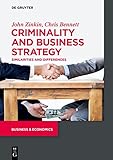Criminality and Business Strategy : Similarities and Differences / John Zinkin, Chris Bennett.
Material type: TextPublisher: Berlin ; Boston : De Gruyter, [2022]Copyright date: ©2022Description: 1 online resource (XV, 202 p.)Content type:
TextPublisher: Berlin ; Boston : De Gruyter, [2022]Copyright date: ©2022Description: 1 online resource (XV, 202 p.)Content type: - 9783110711899
- 9783110712162
- 9783110712155
- HD30.28 .Z546 2022
- online - DeGruyter
- Issued also in print.
| Item type | Current library | Call number | URL | Status | Notes | Barcode | |
|---|---|---|---|---|---|---|---|
 eBook
eBook
|
Biblioteca "Angelicum" Pont. Univ. S.Tommaso d'Aquino Nuvola online | online - DeGruyter (Browse shelf(Opens below)) | Online access | Not for loan (Accesso limitato) | Accesso per gli utenti autorizzati / Access for authorized users | (dgr)9783110712155 |
Browsing Biblioteca "Angelicum" Pont. Univ. S.Tommaso d'Aquino shelves, Shelving location: Nuvola online Close shelf browser (Hides shelf browser)
Frontmatter -- Advance Praise for Criminality and Business Strategy: Similarities and Differences -- Acknowledgments -- Contents -- Introduction -- Chapter 1 The Crime Continuum: The Role of the State -- Chapter 2 The Crime Continuum – The Role of Organized Crime -- Chapter 3 The Criminal Harm Continuum -- Chapter 4 Does the Punishment Fit the Crime? -- Chapter 5 The Criminal Strategy External Continuum -- Chapter 6 The Criminal Strategy Internal Continuum -- Chapter 7 Differences between OC and Legitimate Enterprises -- Chapter 8 Business Strategy Implications -- Chapter 9 Conclusions -- List of Figures -- List of Tables -- About the Authors -- Index
restricted access online access with authorization star
http://purl.org/coar/access_right/c_16ec
Criminality and Business Strategy: Similarities and Differences explores what can be learned from criminal organizations on four continents based on comparisons of their historical and cultural origins, chosen governance and power structures, and business models. It discusses how these contexts determined their applications of the principles and practice of effective, but amoral leadership, and whether these lessons can be applied to legitimate business enterprises. In this book John Zinkin and Chris Bennett argue that defining a "crime" is a contested issue and that criminality can be viewed as a spectrum, comprising a range of different types of crimes, the harms caused, and the variety of punishments involved. They discuss the critical role of the state in determining where criminality is perceived to sit on the crime continuum. The authors delve into how the state and organized crime are natural competitors, and how organized crime and legitimate businesses are subject to many of the same internal and external strategic considerations. They contend that the resulting similarities between criminality in organized criminal organizations and legitimate businesses are greater than the differences and that the differences are only in degree and not in kind. This thought-provoking study of criminality will be of immense interest to professionals, coaches, consultants, and academics interested in the techniques and ethics of leadership. The book is, in effect, the result of an intellectual journey of the authors from the ideas presented in their earlier book, The Principles and Practice of Effective Leadership, to the issues in this book discussing important, difficult, and contested subjects. The journey continues in their third book: The Challenge in Leading Ethical and Successful Organizations.
Issued also in print.
Mode of access: Internet via World Wide Web.
In English.
Description based on online resource; title from PDF title page (publisher's Web site, viewed 02. Mai 2023)









